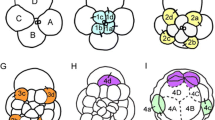Abstract
In the direct-developing sea urchin Heliocidaris erythrogramma the first cleavage division bisects the dorsoventral axis of the developing embryo along a frontal plane. In the two-celled embryo one of the blastomeres, the ventral cell (V), gives rise to all pigmented mesenchyme, as well as to the vestibule of the echinus rudiment. Upon isolation, however, the dorsal blastomere (D) displays some regulation, and is able to form a small number of pigmented mesenchyme cells and even a vestibule. We have examined the spatial and temporal determination of cell fates along the dorsoventral axis during subsequent development. We demonstrate that the dorsoventral axis is resident within both cells of the two-celled embryo, but only the ventral pole of this axis has a rigidly fixed identity this early in development. The polarity of this axis remains the same in half-embryos developing from isolated ventral (V) blastomeres, but it can flip 180° in half-embryos developing from isolated dorsal (D) blastomeres. We find that cell fates are progressively determined along the dorsoventral axis up to the time of gastrulation. The ability of dorsal half-embryos to differentiate ventral cell fates diminishes as they are isolated at progressively later stages of development. These results suggest that the determination of cell fates along the dorsoventral axis in H. erythrogramma is regulated via inductive interactions organized by cells within the ventral half of the embryo.
Similar content being viewed by others
References
Cameron RA, Fraser SE, Britten RJ, Davidson EH (1989) The oral-aboral axis of a sea urchin embryo is specified by first cleavage. Development 106:641–647
Cameron RA, Hough-Evans BR, Britten RJ, Davidson EH (1987) Lineage and fate of each blastomere of the eight cell sea urchin embryo. Genes and Development 1:75–85
Davidson EH (1989) Lineage-specific gene expression and the regulative capacities of the sea urchin embryo: a proposed mechanism. Development 105:421–445
Davidson EH (1990) How embryos work: a comparative view of diverse modes of cell fate specification. Development 108:365–389
Harkey MA, Whiteley AH (1983) The program of protein synthesis during the development of the micromere primary mesenchyme cell line in the sea urchin. Dev Biol 100:12–28
Henry JJ, Amemiya S, Wray GA, Raff RA (1989) Early inductive interactions are involved in restricting cell fates of mesomeres in sea urchin embryos. Dev Biol 136:140–153
Henry JJ, Klueg KM, Raff RA (1992) Evolutionary dissociation between cleavage, cell lineage and embryonic axes in sea urchin embryos. Development 114:931–938
Henry JJ, Martindale MQ (1987) The organizing role of the D quadrant as revealed through the phenomenon of twinning in the polychaete Chaetopterus variopedatus. Roux's Arch Dev Biol 196:499–510
Henry JJ, Raff RA (1990) Evolutionary change in the process of dorsoventral axis determination in the direct-developing sea urchin, Heliocidaris erythrogramma. Dev Biol 141:55–69
Henry JJ, Wray GA, Raff RA (1990) The dorsoventral axis is specified prior to first cleavage in the direct-developing sea urchin Heliocidaris erythrogramma. Development 110:875–884
Hörstadius S (1936) Über die zeitliche Determination im Keim von Paracentrotus lividus Lk. Wilhelm Roux's Arch Dev Biol 135:1–39
Hörstadius S (1957) On the regulation of bilateral symmetry in plutei with exchanged meridianal halves and in giant plutei. J Embryol Exp Morphol 5:60–73
Hörstadius S (1973) Experimental Embryology of Echinoderms. Clarendon Press, Oxford
Hörstadius S, Wolsky A (1936) Studien über die Determination der Bilateralsymmetrie des jungen Seeigel Kiemes. Wilhelm Roux's Arch Dev Biol 135:69–113
Khaner O, Wilt F (1990) The influence of cell interactions and tissue mass on the development of the sea urchin mesomeres. Development 109:625–634
Khaner O, Wilt, F (1991) Interactions of different vegetal cells with the mesomeres during early stages of sea urchin development. Development 112:881–890
Lindahl, PE (1932) Zur experimentellen Analyse der Determination der Dorsoventralachse beim Seeigelkeim. I. Versuche mit gestreckten Eiern. Wilhelm Roux's Arch Dev Biol 127: 300–322
McCain ER, McClay DR (1994) The establishment of bilateral asymmetry in sea urchin embryos. Development 120:395–404
McCarthy RA, Spiegel M (1983) Serum effects on the in vitro differentiation of sea urchin micromeres. Exp Cell Res 149: 433–441
McMillan WO, Raff RA, Palumbi SR (1993) Population genetic consequences of developmental evolution in sea urchins (Genus Heliocidaris). Evolution 46:1299–1312
Okazaki K (1975) Spicule formation by isolated micromeres of the sea urchin embryo. Am Zool 15:567–581
Parks AL, Parr BA, Chin J-E, Leaf DS, Raff RA (1988) Molecular analysis of heterochronic changes in the evolution of direct-developing sea urchins. J Evol Biol 1:27–44
Raff RA (1987) Constraint, flexibility and phylogenetic history in the evolution of direct development in sea urchins. Dev Biol 119:6–19
Raff RA (1992) Direct-developing sea urchins and the evolutionary reorganization of early development. Bio Essays 14: 211–218
Ransick A, Davidson EH (1993) A complete second gut induced by transplanted micromeres in the sea urchin embryo. Science 259:1134–1138
Smith MJ, Boom JDG, Raff RA (1990) Single copy DNA distance between two congeneric sea urchin species exhibiting radically different modes of development. Mol Biol Evol 7:315–326
Williams DHC, Anderson DT (1975) The reproductive system, embryonic development, larval development, and metamorphosis of the sea urchin Heliocidaris erythrogramma (Val.) (Echinoidea: Echinometridae). Aust J Zool 23:371–403
Wray GA, Raff RA (1989) Evolutionary modification of cell lineage in the direct developing sea urchin Heliocidaris erythrogramma. Dev Biol 132:458–470
Wray GA, Raff RA (1990) Novel origins of lineage founder cells in the direct-developing sea urchin Heliocidaris erythrogramma. Dev Biol 141:41–54
Wray GA, Raff RA (1991) The evolution of direct developmental strategies in marine invertebrates. Trends Ecol Evol 6:45–50
Author information
Authors and Affiliations
Rights and permissions
About this article
Cite this article
Henry, J.J., Raff, R.A. Progressive determination of cell fates along the dorsoventral axis in the sea urchin Heliocidaris erythrogramma. Roux's Arch Dev Biol 204, 62–69 (1994). https://doi.org/10.1007/BF00189069
Received:
Accepted:
Issue Date:
DOI: https://doi.org/10.1007/BF00189069




